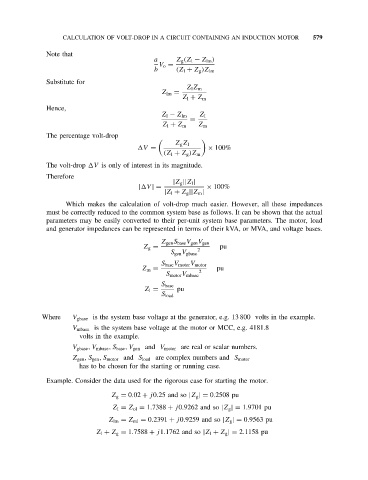Page 586 - Handbook of Electrical Engineering
P. 586
CALCULATION OF VOLT-DROP IN A CIRCUIT CONTAINING AN INDUCTION MOTOR 579
Note that
a Z g (Z l − Z lm )
V o =
b (Z l + Z g )Z lm
Substitute for
Z l Z m
Z lm =
Z l + Z m
Hence,
Z l − Z lm Z l
=
Z l + Z m Z m
The percentage volt-drop
Z g Z l
V = × 100%
(Z l + Z g )Z m
The volt-drop V is only of interest in its magnitude.
Therefore
|Z g ||Z l |
| V |= × 100%
|Z l + Z g ||Z m |
Which makes the calculation of volt-drop much easier. However, all these impedances
must be correctly reduced to the common system base as follows. It can be shown that the actual
parameters may be easily converted to their per-unit system base parameters. The motor, load
and generator impedances can be represented in terms of their kVA, or MVA, and voltage bases.
Z gen S base V gen V gen
Z g = pu
2
S gen V gbase
S base V motor V motor
Z m = pu
2
S motor V mbase
S base
Z l = pu
S load
Where V gbase is the system base voltage at the generator, e.g. 13 800 volts in the example.
V mbase is the system base voltage at the motor or MCC, e.g. 4181.8
volts in the example.
V gbase ,V mbase ,S base ,V gen and V motor are real or scalar numbers.
Z gen ,S gen ,S motor and S load are complex numbers and S motor
has to be chosen for the starting or running case.
Example. Consider the data used for the rigorous case for starting the motor.
Z g = 0.02 + j0.25 and so |Z g |= 0.2508 pu
Z l = Z ol = 1.7388 + j0.9262 and so |Z g |= 1.9701 pu
Z lm = Z ml = 0.2391 + j0.9259 and so |Z g |= 0.9563 pu
Z l + Z g = 1.7588 + j1.1762 and so |Z l + Z g |= 2.1158 pu

